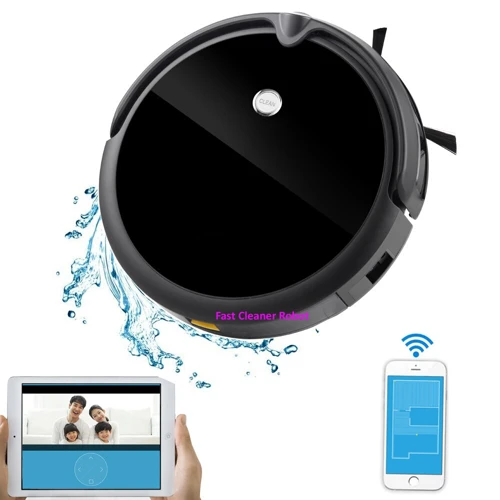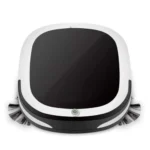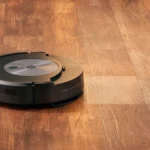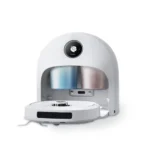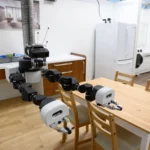Are you tired of manually vacuuming your home all the time? Do you wish you could have a robotic assistant do the job for you? Well, the good news is that technology has advanced to the point where smart vacuum cleaners are a reality. But, what makes these devices so intelligent and efficient at cleaning our homes? One answer to that is camera mapping technology. Yes, you read that right – cameras on vacuum cleaners! In this article, we will explore how camera mapping enhances navigation in smart vacuum cleaners, and how this technology can benefit you. So, let’s dive in and discover how a simple camera can revolutionize our cleaning routines.
Understanding Camera Mapping and Its Role in Navigation

As technology continues to advance, smart vacuum cleaners are becoming more popular due to their ability to efficiently clean homes on autopilot. However, for these devices to operate smoothly, they require advanced navigation systems that accurately detect obstacles and identify the surrounding environment. One of these navigation systems is camera mapping, which plays a crucial role in how the smart vacuum cleaner moves around and cleans the floor. In this section, we will dive into camera mapping technology and its importance in smart vacuum cleaner navigation. To learn more about the basics of camera mapping, check out What is Camera Mapping?. To find out which smart vacuum cleaners feature this technology, head over to our article on Top 5 Smart Vacuum Cleaners with Camera Mapping.
What is Camera Mapping?
Camera mapping is a technology used by smart vacuum cleaners to create a visual map of the cleaning area. This process involves using a camera installed on the robot vacuum and advanced software that processes the images captured by the camera. The result is a digital representation of the environment’s layout, obstacles, topography, and other relevant features. This information helps the robot navigate the cleaning area with more efficiency, speed, and accuracy, and it enhances the vacuum’s overall cleaning quality.
The camera mapping technology used by smart vacuums creates a three-dimensional (3D) map of the cleaning area. It involves using depth perception to determine the size and distance of obstacles and surfaces. This information is then used to create a map that the vacuum can use to navigate the area without bumping into objects or falling off edges like stairs. Additionally, some smart vacuums use Lidar sensors that use lasers for distance calculations and can create more accurate maps.
Camera mapping is one of the most important technologies available to smart vacuum cleaners. The benefits to its use are many, including enhanced cleaning quality, increased efficiency, and more advanced navigation. When buying a smart vacuum cleaner, it is essential to choose a model that uses this technology to ensure that your device has the most advanced features available.
To learn more about the benefits of camera mapping for smart vacuum cleaners, visit our article on “Cam Mapping in Smart Vacuums“. In case you encounter issues with camera mapping technology, you can take a look at our guide “Troubleshoot Camera Mapping Issues in Smart Vacuum Cleaners“.
What’s the Role of Camera Mapping in Smart Vacuum Cleaners Navigation?
Smart vacuum cleaners equipped with camera mapping technology use advanced algorithms and sensors to navigate through a user’s home. Camera mapping plays a critical role in this process by allowing the vacuum cleaner to create a detailed map of the environment and use it to plan its cleaning path effectively. The map, created using a camera attached to the vacuum cleaner, captures hundreds of images, which are then processed to create a 3D model of the environment.
Here are some key ways in which camera mapping enhances the navigation of smart vacuum cleaners:
- Accurate surface detection: Camera mapping enables the vacuum cleaner to identify different types of surfaces, from carpets to hardwood flooring, and adjust its cleaning methods accordingly. This ensures that the vacuum cleaner is optimized for different surfaces, making cleaning more efficient and effective.
- Precise localization: By using the 3D map created using camera mapping, the vacuum cleaner can accurately localize itself in real-time. This means it can better navigate around furniture and other obstacles while avoiding collisions and minimizing any damage.
- Efficient obstacle avoidance: Using camera mapping, the vacuum cleaner can detect obstacles in its path and avoid them with precision. This not only helps to protect the vacuum cleaner from damage but also ensures that cleaning is more efficient as it doesn’t need to stop and start repeatedly when encountering obstacles.
- Improved cleaning in hard-to-reach areas: With the help of camera mapping, the vacuum cleaner can recognize and locate hard-to-reach areas and clean them thoroughly. This means that even areas under furniture or other inaccessible spaces can be cleaned with greater efficiency and precision.
Camera mapping is crucial for improving the navigation and overall performance of smart vacuum cleaners. The advanced mapping techniques and algorithms help vacuum cleaners to create detailed maps of the environment and use them to navigate, clean, and avoid obstacles with greater precision. If you are looking for a highly efficient and effective way to clean your home, it’s worth considering a smart vacuum cleaner with camera mapping technology.
How Camera Mapping Helps Smart Vacuum Cleaners Navigate
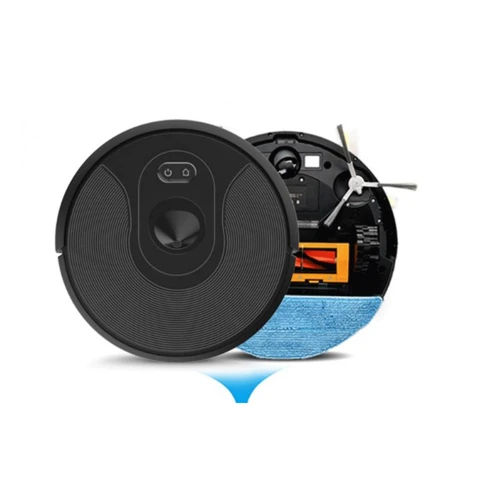
As smart home technology continues to advance, home appliances have become increasingly sophisticated. One such innovation is the integration of camera mapping technology in smart vacuum cleaners. Through this cutting-edge technology, these cleaning devices can now navigate through homes more effectively, and with greater precision. In this section, we will dive deeper into how camera mapping enhances the navigation of smart vacuums, highlighting the benefits of this technology for homeowners.
1. Accurate Surface Detection
Smart vacuum cleaners equipped with camera mapping technology are able to accurately detect and map the surfaces they are cleaning. This feature is particularly beneficial for homes with varied flooring surfaces, as the vacuum can automatically adjust its settings to optimize cleaning on each surface type.
Here are some of the ways that accurate surface detection from camera mapping enhances navigation in smart vacuum cleaners:
- Optimal Cleaning Settings: Using camera mapping technology, the vacuum can differentiate between tile, hardwood, and carpeted surfaces, and adjust its suction and brush roll speed accordingly. This ensures a more effective and efficient cleaning process, with minimal energy wasted on incorrect cleaning settings.
- Non-Contact Detection: Unlike traditional vacuum cleaners that rely on physical contact with the surface to detect it, smart vacuums with camera mapping can detect surfaces through visual cues. This means less wear and tear on the vacuum, as well as less disruption to items on the floor that may be moved by physical detection.
- Accurate Mapping: By accurately detecting and mapping various surface types, the vacuum can create a more precise and detailed map of your home’s layout. This leads to more efficient cleaning routes and the ability to focus on high-traffic areas that may require extra attention.
- Improved Navigation: With accurate surface detection, the vacuum can also better navigate around obstacles such as furniture legs or rug edges, without getting stuck or missing spots. This leads to a more thorough cleaning process and a better overall experience for the user.
The ability of smart vacuum cleaners with camera mapping to accurately detect and map surfaces is a key feature that enhances navigation, cleaning performance, and user experience. If you have varied flooring surfaces in your home, investing in a smart vacuum with this technology can greatly simplify and optimize your cleaning routine.
2. Precise Localization
One of the ways that camera mapping enhances navigation in smart vacuum cleaners is through precise localization. This refers to the ability of the vacuum cleaner to accurately determine its location within a room or space, which is essential for efficient cleaning.
Here are some key points to understand about how camera mapping enables this precise localization:
- Real-time updates: A smart vacuum cleaner equipped with camera mapping technology constantly captures images of its surroundings, and algorithms process this information to generate a real-time map of the space. As the vacuum cleaner moves around, the map is constantly updated to reflect any changes in the environment. This allows for precise localization, down to the exact location of furniture or other obstacles within a room.
- Better navigation: By having access to accurate data about its position within a room, a smart vacuum cleaner with precise localization can navigate more efficiently. It can calculate the most efficient path to take through a space, avoid areas it has already cleaned, and dynamically adjust its cleaning pattern as it encounters new obstacles. This leads to faster and more thorough cleaning, with less time wasted on redundant or inefficient movements.
- Multi-room cleaning: Another benefit of precise localization is that it allows smart vacuum cleaners to move seamlessly between different rooms or areas within a home. By keeping track of its position as it moves from one room to the next, a vacuum cleaner equipped with camera mapping technology can ensure it covers every area of the home equally, without needing to be manually moved from room to room.
Precise localization through camera mapping technology is a key factor in enabling smart vacuum cleaners to clean more efficiently and effectively. By providing real-time updates and better navigation, these devices can save time and energy while still ensuring that every inch of your floors is clean.
3. Efficient Obstacle Avoidance
Smart vacuum cleaners with camera mapping are able to navigate efficiently around obstacles thanks to their advanced sensors and mapping technology. As the cleaner moves around a room, it creates a detailed map of the environment, including the location and size of furniture, walls, and other obstacles. This map is constantly updated in real-time as the vacuum cleaner moves, allowing it to move around obstacles with ease.
One way these vacuums do this is by using path planning algorithms that take into account the map of the environment created by the camera mapping system. These algorithms help the vacuum cleaner calculate an optimal path to clean a given area while avoiding any obstacles in its way. This not only helps to ensure that the vacuum cleaner is able to clean every corner of the room, but it also helps to prevent it from getting stuck or tangled up.
Another key aspect of obstacle avoidance in smart vacuum cleaners with camera mapping is their use of edge detection technology. This allows the vacuum cleaner to distinguish between walls and other obstacles, and to avoid bumping into them. By using this technology, the vacuum cleaner is able to navigate more effectively around the edges of a room, and can clean closer to furniture and other objects without causing damage.
Smart vacuum cleaners with camera mapping also benefit from cliff detection technology, which helps them avoid falling down stairs or other drop-offs. This technology uses sensors to detect changes in height, and can help the vacuum cleaner stay on track even in environments with multiple levels or uneven flooring.
Efficient obstacle avoidance is a key benefit of smart vacuum cleaners with camera mapping. By using a combination of path planning, edge detection, and cliff detection technologies, these vacuums are able to navigate more effectively around any obstacles in their path, and can provide more thorough cleaning results in less time.
4. Improved Cleaning in Hard-to-Reach Areas
One of the many advantages of camera mapping technology in smart vacuum cleaners is that it helps them clean hard-to-reach areas effectively. Here are some specific ways in which camera mapping enhances a smart vacuum cleaner’s ability to tackle these challenging areas:
- 1. Targeted Cleaning – With camera mapping, smart vacuums can accurately detect and locate areas that require extra attention, such as under furniture, behind cabinets or in tight corners. By focusing on these areas, the vacuum cleaner can ensure that no dust or debris is left behind. This feature is particularly useful for individuals who have limited mobility or face difficulties accessing certain parts of their homes.
- 2. Increased Reach – Smart vacuums equipped with camera mapping can scan the environment and detect obstacles in their way. This feature allows them to navigate around objects and reach difficult spots that traditional vacuums might miss. For example, they can clean the top of bookshelves and wardrobes or reach tight spaces behind machinery or appliances. This makes cleaning more thorough and ensures that even hard-to-reach areas are kept clean and free of dust.
- 3. Efficient Cleaning – Camera mapping technology allows smart vacuums to create a map of the environment in real time. This information helps the vacuum cleaner plan its route and avoid cleaning the same area multiple times. This ensures that the vacuum cleaner spends more time cleaning hard-to-reach areas and less time overlapping areas that have already been sufficiently cleaned. This improves the overall efficiency of the cleaning process and ensures that all areas are cleaned effectively.
Camera mapping technology in smart vacuum cleaners helps them clean hard-to-reach areas accurately and efficiently. This makes cleaning easier and more effective, especially for individuals with mobility issues. By investing in a smart vacuum cleaner with camera mapping technology, you can ensure that even the most challenging areas in your home are cleaned thoroughly.
Examples of Smart Vacuum Cleaners Using Camera Mapping Technology
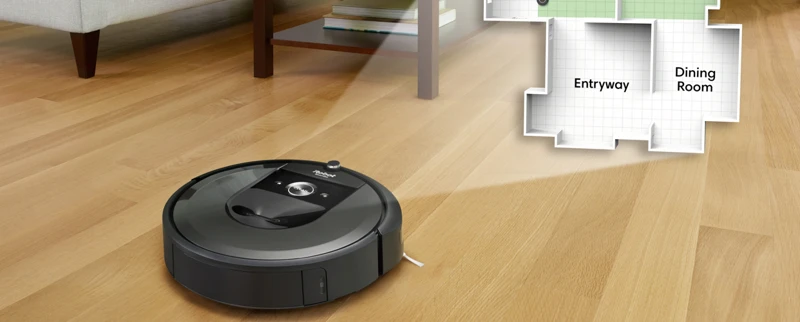
If you’re in the market for a new smart vacuum cleaner and are curious about camera mapping technology, here are some examples of top-rated models that use it to enhance navigation and cleaning efficiency:
1. iRobot Roomba S9+
The iRobot Roomba S9+ is one of the most advanced smart vacuum cleaners on the market, thanks in part to its sophisticated camera mapping technology. Equipped with a state-of-the-art navigation system that uses a combination of high-resolution cameras and advanced sensors, the Roomba S9+ is able to accurately map and navigate your home’s floor plan. This allows it to clean efficiently and thoroughly, even in tight spaces and hard-to-reach corners.
2. Neato Botvac D7 Connected
Another highly rated smart vacuum cleaner that uses camera mapping technology is the Neato Botvac D7 Connected. Equipped with a powerful mapping system that relies on advanced laser sensors and high-resolution cameras, the Botvac D7 can quickly create a comprehensive map of your home’s layout. This allows it to navigate around obstacles and furniture with ease, while also ensuring that it covers every inch of your floors.
3. Ecovacs Deebot Ozmo T8 AIVI
For those who want a smart vacuum cleaner that offers even more advanced features, the Ecovacs Deebot Ozmo T8 AIVI is an excellent choice. This model uses a sophisticated camera mapping system that can even recognize and avoid common household obstacles like shoes, cords, and pet toys. It also offers live streaming video capabilities, which allows you to monitor your home and pets from your smartphone while your vacuum cleaner does the cleaning.
4. Shark IQ Robot Self-Empty XL
If you’re looking for a smart vacuum cleaner that can handle large homes and long cleaning sessions without needing frequent bin emptying, the Shark IQ Robot Self-Empty XL is a top-rated model that uses camera mapping technology. It’s able to clean and navigate your home using a series of advanced camera sensors, which allow it to map your entire floor plan and avoid obstacles with ease. With its large-capacity self-emptying bin, you can let it run for weeks without having to worry about frequent maintenance.
By choosing a smart vacuum cleaner with camera mapping technology, you can enjoy a more efficient and thorough cleaning experience, as well as a range of advanced features that make cleaning easier than ever before.
How You Can Benefit from a Smart Vacuum Cleaner with Camera Mapping

A smart vacuum cleaner equipped with camera mapping technology offers numerous benefits to its users. One of the biggest advantages is that it can navigate with greater precision and accuracy compared to conventional smart vacuum cleaners. This is because camera mapping technology allows the device to map the entire room, identify obstacles and floor surface conditions, and accurately navigate around the furniture and other objects.
Another benefit is that it can clean hard-to-reach areas easily and effectively. With camera mapping, the smart vacuum cleaner can detect and recognize corners, edges, and other areas that need special attention. This means that you can achieve a more thorough clean-up and maintain a healthier living environment.
A smart vacuum cleaner with camera mapping technology can also save you time and energy. With a more accurate and efficient navigation system, it can perform cleaning tasks in less time than traditional smart vacuum cleaners. You don’t have to spend hours pushing the cleaner around, which leaves you with more time to relax or do other more important things.
It can improve your indoor air quality by trapping allergens, dust, and other harmful particles. The advanced filter technology in camera mapping smart vacuums can capture tiny airborne pollutants, which will significantly improve the quality of the air in your home.
A smart vacuum cleaner with camera mapping technology can also offer you the convenience of phone or voice control. With connectivity to smart home hubs, you can easily control the device with a few clicks on your phone or using voice commands. This means you can control the smart vacuum cleaner’s cleaning schedule and cleaning operation even when you’re not at home.
Finally, a smart vacuum cleaner with camera mapping technology can save you money on professional cleaning services. Since it can work autonomously and provide you with a thorough and regular clean-up, you don’t have to hire professional cleaners frequently. This will save you money in the long run and provide you with a cleaner home environment.
A smart vacuum cleaner equipped with camera mapping technology can provide you with numerous benefits, including greater precision and accuracy, better indoor air quality, and convenience. These factors make it an ideal investment for homeowners seeking a smarter, cleaner living environment.
Factors to Consider when Buying a Smart Vacuum Cleaner with Camera Mapping
When it comes to purchasing a smart vacuum cleaner with camera mapping, it’s important to consider various factors to ensure you make an informed decision. With the rise of technology, there are numerous options available in the market, making it difficult to determine which vacuum cleaner meets your needs. Before making the purchase, it’s crucial to understand certain important factors that can affect your decision. These factors range from mapping quality, battery life, dustbin capacity, to connectivity and smart features. In this section, we’ll discuss each factor in detail, providing insights that will help you make a wise purchase.
1. Mapping Quality and Accuracy
When it comes to buying a smart vacuum cleaner with camera mapping technology, the mapping quality and accuracy should be your top priority. The better the mapping quality and accuracy, the more efficient and effective the cleaning process will be. Here are some factors to consider:
1. Sensors: The cleaner’s mapping ability heavily relies on its sensors. Look for a model with high-quality sensors that can accurately detect and map your home’s layout. The more sensors a cleaner has, the more details it can gather about the environment, leading to better mapping and navigation.
2. Mapping software: The software used to map your home is just as important as the sensors. The cleaner should have a sophisticated mapping software that can accurately interpret and analyze the sensor data. It should also be able to learn and adapt to changes in the environment.
3. Mapping speed: A cleaner’s speed in mapping your home can affect its accuracy. Some models take longer to map while others are faster. A slower mapping speed is not necessarily a bad thing as long as it results in accurate mapping.
4. Mapping completeness: A cleaner that can map the entirety of your home’s layout accurately can do a better job cleaning. Ensure that the model you’re considering can create a complete and detailed map of your home.
5. Mapping Updates: The ability of a smart vacuum cleaner to update its map over time is vital to maintaining its accuracy. Choose a model that can update its map as it cleans, ensuring it can navigate through your home effectively.
To summarize, mapping quality and accuracy are fundamental considerations when choosing a smart vacuum cleaner with camera mapping technology. High-quality sensors, sophisticated mapping software, adequate mapping speed, completeness, and the ability to update maps over time are essential to ensure an efficient and thorough cleaning process.
2. Battery Life and Energy Efficiency
Factors to Consider when Buying a Smart Vacuum Cleaner with Camera Mapping: Battery Life and Energy Efficiency
Another important factor to consider when buying a smart vacuum cleaner with camera mapping is its battery life and energy efficiency. After all, what good is a high-tech smart vacuum cleaner if it can only clean for a few minutes before running out of battery?
To help you assess which smart vacuum cleaners have the best battery life and energy efficiency, we’ve put together a table of some of the top models on the market:
| Smart Vacuum Cleaner Model | Battery Life | Charge Time | Energy Efficiency |
|---|---|---|---|
| iRobot Roomba i7+ | 75 minutes | 2 hours | high |
| Xiaomi Mi Robot Vacuum | 150 minutes | 3 hours | medium |
| Ecovacs Deebot N8 Pro | 110 minutes | 4 hours | high |
| Shark IQ Robot Self-Empty | 90 minutes | 3 hours | high |
As you can see, different smart vacuum cleaner models offer different levels of battery life and energy efficiency. While the Xiaomi Mi Robot Vacuum boasts an impressive 150 minutes of battery life, its charge time is also longer than other models, at 3 hours. On the other hand, the Shark IQ Robot Self-Empty has a shorter battery life of 90 minutes but charges in only 3 hours. It’s important to consider the trade-offs and choose a smart vacuum cleaner that aligns with your cleaning needs.
In addition to battery life and energy efficiency, many smart vacuum cleaners offer features such as auto-docking and recharging, which can help you keep your device powered up and ready to go at all times. Make sure to read reviews, compare prices, and weigh the pros and cons of each model before making your final decision.
3. Dust Bin Capacity and Filter Quality
When it comes to buying a smart vacuum cleaner with camera mapping, dust bin capacity and filter quality are important factors to consider. A larger dust bin capacity means less frequent emptying and a higher cleaning efficiency. A good filter quality ensures that the vacuum cleaner picks up even the smallest particles and keeps the air in the room clean. Let’s take a closer look at each of these factors.
| Factor | Importance | Features to Look for |
|---|---|---|
| Dust Bin Capacity | High | A larger dust bin capacity will reduce the number of times you need to stop cleaning to empty the bin, resulting in higher cleaning efficiency. Look for models with dust bin capacities of 0.5 liters or more. |
| Filter Quality | High | A good filter quality ensures that even the smallest particles are picked up and that the air in the room remains clean. Look for models with HEPA filters or other high-quality filters that can trap particles as small as 0.3 microns. |
When it comes to dust bin capacity, it’s important to note that larger capacities may mean a heavier vacuum cleaner. So, it’s important to strike a balance between dust bin capacity and the weight of the vacuum cleaner.
In terms of filter quality, HEPA filters are considered to be the gold standard. These filters can trap particles as small as 0.3 microns, making them highly effective at picking up allergens and other small particles. However, other high-quality filters, such as those made from activated carbon or foam, can also be effective.
When shopping for a smart vacuum cleaner with camera mapping, it’s important to consider the dust bin capacity and filter quality to ensure you get a model that meets your cleaning needs and keeps your home free of unwanted dust and debris.
4. Connectivity and Smart Features
When buying a smart vacuum cleaner with camera mapping, it’s important to consider the connectivity and smart features it offers. Here are some factors to keep in mind:
- Wi-Fi Connectivity: A smart vacuum cleaner should have Wi-Fi connectivity, allowing you to control it via your smartphone or virtual assistant. This will enable you to manage your cleaning tasks remotely, even when you’re away from home.
- Virtual Mapping: Some smart vacuum cleaners can create a virtual map of your home as they clean, allowing you to track their progress and determine cleaning patterns. This will enable you to customize their cleaning behavior to meet your specific needs.
- Voice Control: If voice control is important to you, ensure that the smart vacuum cleaner you choose is compatible with your virtual assistant (like Alexa, Google Home etc.). This will enable you to control your smart vacuum cleaner with simple voice commands.
- Scheduling and Auto Recharge: Smart vacuum cleaners that offer scheduling and auto recharge capabilities will make your life much easier. You can set the vacuum cleaner to clean at specific times, and when it runs out of battery, it will automatically return to its docking station to recharge.
When buying a smart vacuum cleaner with camera mapping, consider its connectivity and smart features. Look for a vacuum cleaner with Wi-Fi connectivity, virtual mapping, voice control, and scheduling and auto recharge capabilities. These features will make using the vacuum cleaner much more convenient and efficient.
Closing Thoughts
As we conclude this article, it’s clear that camera mapping is a game-changing technology that has transformed the way smart vacuum cleaners navigate and clean our homes. Thanks to this technology, smart vacuums have become more efficient, effective, and reliable than ever before.
Without camera mapping technology, smart vacuums may have struggled to navigate through complex environments, locate their exact positions, and avoid obstacles that would otherwise damage them.
However, with the integration of camera mapping technology, smart vacuums can now effortlessly scan and map their surroundings, locate their exact positions, and efficiently navigate around every nook and cranny of our homes. This has resulted in a more thorough and effective cleaning experience that saves us time and effort.
The benefits of camera mapping technology are not limited to smart vacuums alone. Many other smart home devices, such as robots and drones, are now integrating this technology to enhance their navigation and functionality.
So, if you’re in the market for a new smart vacuum cleaner, we highly recommend considering one with camera mapping technology. It may cost a bit more, but the benefits are countless.
Just remember to consider the mapping quality and accuracy, battery life and energy efficiency, dust bin capacity and filter quality, and connectivity and smart features before making your final decision. With these factors in mind, you’re sure to find the perfect smart vacuum cleaner that will provide you with a superior cleaning experience for years to come.
Camera mapping technology has revolutionized the way we clean our homes and made it easier than ever before. With further advancements in artificial intelligence and machine learning, we can expect to see even more innovative and exciting features added to smart vacuum cleaners and other smart home devices in the near future.
Frequently Asked Questions
1. How does camera mapping work in smart vacuum cleaners?
Camera mapping in smart vacuum cleaners uses high-quality cameras to take pictures of the surrounding environment. These pictures are then analyzed to create a map of the room or space, which the vacuum cleaner uses to navigate and clean efficiently.
2. Can the camera mapping technology in smart vacuum cleaners detect obstacles accurately?
Yes, smart vacuum cleaners with camera mapping technology use sensors and cameras to detect obstacles accurately, allowing the cleaner to navigate around obstacles and avoid collisions.
3. Do smart vacuum cleaners with camera mapping technology require internet connectivity?
No, not all smart vacuum cleaners with camera mapping technology require internet connectivity. However, some models provide advanced features like app controls that may require internet connectivity.
4. How do smart vacuum cleaners with camera mapping technology clean hard-to-reach areas?
Smart vacuum cleaners with camera mapping technology are equipped with advanced sensors and cameras that allow them to detect and navigate through tight spaces, including under furniture and between obstacles. These features make them ideal for cleaning hard-to-reach areas.
5. What is the impact of camera mapping technology on battery life in smart vacuum cleaners?
Camera mapping technology may have an impact on the battery life of smart vacuum cleaners since it requires a lot of power to process images and create accurate maps of the environment. To preserve battery life, some models may reduce the frequency of image capture or stop mapping completely when the battery level is low.
6. How accurate are the maps created by smart vacuum cleaners with camera mapping technology?
The accuracy of the maps created by smart vacuum cleaners with camera mapping technology depends on the quality of the camera and sensors used. High-quality sensors and cameras can create precise and detailed maps that can help the vacuum cleaner navigate efficiently.
7. How often do you need to empty the dust bin and replace the filters in smart vacuum cleaners with camera mapping technology?
The frequency of emptying the dust bin and replacing filters in smart vacuum cleaners with camera mapping technology depends on the model and frequency of use. However, most models have a large dustbin capacity and high-quality filters that require less frequent emptying and replacement.
8. Do smart vacuum cleaners with camera mapping technology work well on carpets?
Yes, smart vacuum cleaners with camera mapping technology work well on carpets since they use advanced navigation and mapping features to detect and avoid obstacles and clean efficiently. However, it’s important to look for models with strong suction power and brush rolls for deeper carpet cleaning.
9. Can smart vacuum cleaners with camera mapping technology remember multiple floor plans?
Yes, some smart vacuum cleaners with camera mapping technology can remember multiple floor plans and switch between them based on the location of the dock or other specific triggers. This feature makes it easy to clean different floors or areas without the need to remap each time.
10. How much does a smart vacuum cleaner with camera mapping technology cost?
The cost of a smart vacuum cleaner with camera mapping technology depends on the brand, features, and quality. However, you can find models ranging from around $200 to over $1,000. It’s important to consider your needs and budget before making a purchase.
